Josephine Baker: Superstar, War Hero and Activist
Josephine Baker was born in 1906 as Freda Josephine MacDonald in St Louis, Missouri. Her mother Carrie was a washerwoman and ex-vaudeville girl, her father was a drummer named Eddie Carson who ran off when Josephine was only a little girl. Before he left he and Carrie had done some stage shows together (reputedly even bringing young Josephine on stage), and it may have been his abandoning her that gave Carrie her dislike of showbusiness. Naturally her mother’s disdain only fuelled young Josephine’s interest in the stage, though it took her a while to get there. For most of her childhood, her sanctuary and refuge from life was the Booker Washington Theatre, named for the famous black civil rights pioneer.
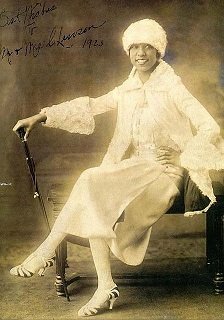
Josephine’s first job was as a domestic servant, hired out to white families by her mother. There she was a cleaner and a babysitter (though one white mother warned her not to dare kiss the babies). She also performed on street corners to raise pocket money, and perhaps to escape from the grim reality of life for a poor black girl in St Louis. She was definitely physically abused by her employers (one woman burned her hands for wasting laundry soap), and was almost certainly sexually abused by them as well. At the age of thirteen she got a job working in an ice-cream parlour ran by a man known in her biography only as “Mr Dad”. By this stage Josephine’s mother had effectively kicked her out of the family home for her to get room and board from her employers, and a persistent rumour began that he was getting more in exchange from her than her waitressing. When word reached Carrie’s ears, she was mortified by the scandal. She dragged Josephine out of the ice cream shop, and at the advice of Josephine’s godmother had her married off to a steelworker named Willie Wells.
Josephine was still only thirteen when she was “married”, something which made it illegal in Missouri at the time. [1] The marriage didn’t last – Josephine spent more than Willie made, and the two quarrelled bitterly. The last straw came when she claimed to be pregnant, but then turned out to be lying. The two split up. Josephine began working as a waitress (some rumours also have it that she moonlighted as a prostitute), and at the age of 15 she finally made it onto the stage at the Booker Theatre. Though she lacked training, her enthusiasm and spark made up for it, and she was hired. She was a fast learner, and took to the life with enthusiasm. Before long she abandoned St Louis for Memphis, joining Bob Russell’s troupe of performers. She got the job through the influence of Clara Smith, a blues singer who Josephine had been watching on stage since she was a little girl. Josephine became Clara’s protege, avidly studying everything that made Clara a success. She also found her way into Clara’s bed – Josephine was bisexual, though discreetly so, throughout her life; and such relationships were a generally accepted part of life on the road for performers like them. Josephine’s role in the troupe was as the last girl on a chorus line – traditionally the comic relief. The last girl was always making mistakes, in an amusing fashion, until the dancers came back onstage for the encore. There she would show her true skill. It was a grounding in physical comedy that would become a hallmark of Josephine’s style.

In 1921 Josephine was in Philadelphia, where she was married to a man named Willie Baker. The marriage was legal under Pennsylvania laws, though ironically Josephine thought it wasn’t. She thought she was committing bigamy, and claimed on the license that Josephine Wells was her maiden name. (Since her first marriage wasn’t legal, she wasn’t.) She also lied about her age, though 15 was actually a legal age to be married in Pennsylvania at the time. The same year destiny came calling, in the shape of Shuffle Along. Nowadays Shuffle Along is considered a legendary show, but at the time it was just an oddity – a musical written by four black men that was struggling around the New Jersey and Philadelphia circuits. Still, Josephine heard they were hiring dancers so she got a friend to put in a good word. She was hired, though they decided not to put her on stage until she turned 16 in 1922. By that time the show had managed to find a small stage on Broadway to open on, and had turned out to be the sleeper hit of the year. Josephine took her slot as the last dancer on the line – the comic relief – and she nailed it. The show stayed on Broadway until July 1922, then went on tour until 1924. It made nine million dollars, and it launched a slew of superstar careers – people who became household names. Paul Robeson sang in the chorus, and Adelaide Hall was on the line of dancers with Josephine. But she held her own in this exalted company. One critic wrote:
One of the chorus girls is without question the most limber lady of whatever hue the stage has yet disclose. Her name may be printed somewhere in the program…but it should be placed outside in lights…The eyes of this gazelle also defy all known laws as they play hide and seek with the lady’s nose as goal. I’ve seen nothing funnier.
Two of the writers of Shuffle Along, Eubie Blake and Noble Sissie, collaborated on a followup piece. They called it In Bamville, and it was their attempt to create a more mainstream musical with a black cast, and move beyond the racial stereotypes they’d been forced to include in Shuffle Along. [2] They wrote a part in it especially for Josephine, who’d caught their eye for her comedy capers on the chorus line. She’d caught more than Eubie’s eye, though that was hardly unusual. He was notorious for having slept with most of the chorus girls from Shuffle Along, and Josephine was no exception. This might be why he listened when she insisted she be allowed to stretch herself past comedy and into “vamping” in one scene. The show (renamed Chocolate Dandies) closed in May of 1925, around the time Josephine was divorcing Billy Baker. (Something she never quite finished doing legally, though the marriage was over.) It had been a stressful show, and Josephine was owed over a thousand dollars in back pay. She got a part in a show on Broadway, and was playing there when Caroline Reagan came to see her perform.
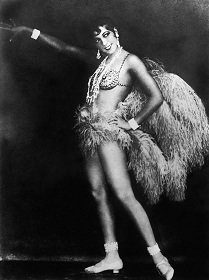
Caroline was from Chicago, and she had spent some time in Paris when her husband (a diplomat) was posted there. At the time American jazz and vaudeville was becoming a big deal in Europe, and Caroline decided that what she wanted to do was take a company of genuine American black entertainers on tour. Though she had some difficulty persuading any French theatre to put on such a production (they all thought themselves far too grand for that), she eventually found a theatre that was large enough to host what she wanted to do, and close enough to bankruptcy to agree to do it. With that in place she headed to New York and started looking around the shows. She set her sights on Josephine, and though initially reluctant Josephine was eventually convinced by her friends not to pass it up. [3] Caroline took a company of twenty back to Paris – twelve musicians and eight chorus girls, joined by some native French black performers to form La Revue Negre.
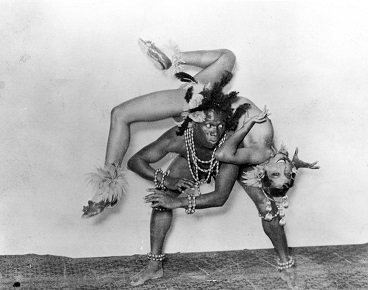
The show opened in Paris on the 2nd October 1925. The show included Josephine doing the Charleston and performing her comedy routines. In the final number one of the French dancers, a native of Martinique named Joe Alex, joined a topless Josephine on stage for the final number- the erotically charged La Danse Sauvage. The show was a huge success. Paris fell in love with Josephine Baker, and Josephine fell in love with Paris right back. She was an immediate celebrity, and she took to the fame like a fish to water. La Revue Negre had been booked for a fortnight – in the end it played for ten weeks to packed houses. In December the show moved to Berlin, where it was less of a success, but still a hit. Josephine was as much of a star in Berlin as Paris, but she worked hard for it. Two shows a night, and then out partying until 4am – not just having fun, but networking, looking for the next big chance. Everyone was trying to hire out from under Caroline, and Paul Derval – manager of the Folies Bergere, the greatest cabaret theatre in Paris – was the one who succeeded. Josephine broke her contract and headed back to Paris.
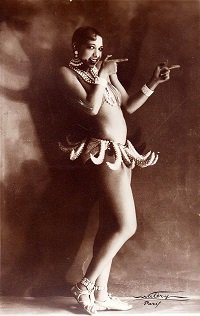
It was in her debut performance at the Folies Bergere that Josephine wore what became her most famous outfit – her banana skirt. The skirt, consisting of a dozen fake bananas threaded on string and slung around her hips, was designed to emphasise Josephine’s movements on stage, and her performance – a precisely calculated mixture of comedy and eroticism – cemented her position as the leading attraction of the Folies Bergere, and the preeminent black entertainer in France. Luckily for us a film clip of that initial performance survives, giving us a brief glimpse of this legendary performance. It was in 1927 that Josephine also starred in her first actual film – a role in a silent movie that was partially inspired by her Folie Bergere performance. In La Sirene des Tropiques Josephine plays Papitou, a young native girl rescued from peril by the hero. She falls in love and follows him back to Paris, getting embroiled in the intrigues of his fiancee’s stepfather. It wasn’t a huge hit, but it did help to raise Josephine’s profile. The film did set one noticeable precedent – as with all of her movies, Josephine didn’t wind up with the film’s (white) hero at the end. France’s tolerance only went so far.
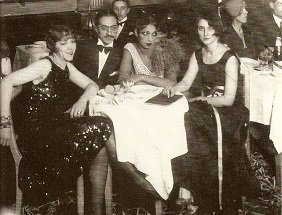
Through the end of the 1920s and into the 1930s, Josephine’s star continued to rise. As with many American artists, in order to get around the restriction on non-French residents performing in a show she became the owner of a Parisian business. Unlike many of those, she wasn’t just doing this as a dodge – her nightclub, Chez Josephine, became a successful venue and even today several nightclubs (including one in her old home of New York City, which we’ll talk about later) take its name in the hope of grabbing some of that glory. Josephine was part of the rising “Negritude” – the conception of a racial African identity that arose in France in the 1930s. This was a resistance to assimilation on the grounds that the culture they were assimilating into regarded them as barbaric, and by becoming part of that culture they were implicitly agreeing with that view. The independent thinking it promoted created a unique sensibility that ironically became a core part of the Parisian scene of the 1930s.
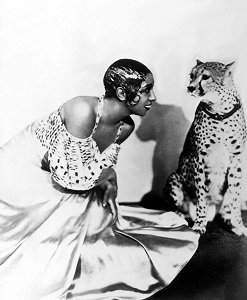
Josephine used the image of the “Negritude” for her own gain, but at this stage in her life she didn’t really buy into the racial identity part of it. In her two films of the 1930s, where she once again plays the part of the racial outsider, who the hero flirts with but sets aside at the end in favour of a comfortably white and conventional heroine. Still, the first of these films remains a classic simply for its autobiographical undertones. Zouzou has Josephine in the title role as a young girl raised in a French circus with an adopted brother named Jean, who she falls in love with. It has a plot revolving around Jean being falsely imprisoned and Zouzou accidentally winding up on stage and becoming a star, using her new fame to raise the money free him. Of course at the end Jean gets a different girl while Zouzou is left with her one remaining love – performing. Josephine herself said of Zouzou that it was the role closest to her own personality, and the sheer joy she puts into her performance makes this believable. The same year (1934) she had starred in an opera written specifically for her, and her vocal training had transformed her from a cabaret singer into a true talent. Too much of a talent for some – when she decided to return to New York to do a show in 1936, American critics reacted with hostility to this black woman with the effrontery to try to be a real singer and not a music hall turn. TIME Magazine infamously referred to her as
[J]ust a slightly buck-toothed young Negro woman whose figure might be matched in any night-club show, and whose dancing and singing might be topped almost anywhere outside of Paris.
Josephine was horrified at the reviews, and at the prejudice she was shown in the city. She had also aroused the indignation of many black Americans by speaking in favour of the invasion of Ethiopia by Mussolini. Most of them saw this war as a racial one – colonial whites invading Africa. Josephine, on the other hand, followed the path of many French intellectuals of the time by applauding Mussolini for toppling an empire that still practised slavery. Attacked on both sides, Josephine quit the show and retreated back to Paris, where she immediately began the process of getting her French passport by the expedient step of marrying a Frenchman named Jean Lion. In 1937 she became a French citizen. When war broke out in 1939 she went to the Maginot line, to entertain the troops. France had become her home, it had welcomed her and she saw an opportunity to serve it. That year she was approached by Jacques Abtey, head of military intelligence in Paris. Josephine had three key qualifications – she was intelligent, she had a good cover for moving around Europe, and she was willing to work for free – which meant she couldn’t be bought. (For her part, Josephine found Jacques intriguing and attractive, and the two began an affair that was the perfect cover for their meetings.) That was how Josephine Baker became a spy.
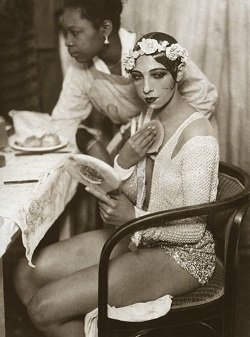
Josephine began her career by collecting gossip at the Parisian embassies – both the Japanese and the Italian ambassadors were fans, and she was easily able to get invitations to their parties. Things got more nervous as the Germans began to move into France however. Josephine’s husband Jean got her to use her influence to get him and his family visas out of the country, though the fact that he seemed to be unconcerned for her safety enraged her and effectively ended the marriage, such as it was. Jacques too needed her help – if captured by the Germans or by the puppet government they were installing, he faced a grim and certain fate. Josephine helped him to hide out, and Jacques in turn gave her news of the Free French government that de Gaulle was installing in London. Josephine continued to gather information, but by August of 1940 the Nazi occupiers of Paris banned black and Jewish performers from the stage. Luckily for Josephine her friends in the Italian and Japanese embassies gave her a degree of protection, but it was clear that France was getting too hot. A plan was hatched. Josephine would head to Portugal through northern Africa, her music sheets filled with information written in invisible ink and intended for the spies there. With her would go Abtey, who would sail from Lisbon to England. The first port of call was a city now synonymous with World War 2 intrigue – Casablanca.
The plan didn’t go entirely smoothly. Though Josephine got herself a Portuguese visa, she couldn’t get one for Jacques. He headed back in to France, while she went on to Tangiers – a city where she had a lot of friends, as she had filmed a movie called Princess Tam Tam there only a few years previously. [4] One of those was the Caliph’s chamberlain, Ahmed Ben Bachir, who got her a safe conduct pass that allowed her to travel freely throughout North Africa. She made her way to Lisbon and delivered her music scores to the French spies there, played a few sellout concerts for some much needed cash, then headed back to Morocco (with, according to legend, secret notes pinned inside her underwear). Jacques eventually joined her there, and the pair continued to gather and deliver information. At some point Josephine became pregnant, though doctors had told her years earlier she wouldn’t be able to have children. They were proved right in June of 1941 when the baby was stillborn, and Josephine developed serious peritonitis. She wound up being hospitalised for nearly eighteen months. While she was in the hospital America entered the war, and by the time she was able to leave in December of 1942 the Allies had captured Casablanca.
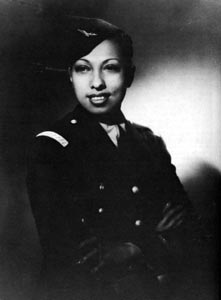
During her illness rumours of Josephine Baker’s death had abounded, and many papers in America had published obituaries. But she was alive, and General Charles de Gaulle was prepared to make use of her. A genuine French superstar who had served as a spy in occupied territory and now stood ready to rally all true Frenchmen to his side – it was a propaganda dream. While the recovered Josephine was touring North Africa, this time to entertain the Allied troops as she had entertained the French defenders in 1939, he gave her the rank of Lieutenant in the Free French Air Force in recognition of her service. Josephine spent the rest of the war performing for the troops, with her image being a key part of Free French propaganda. Josephine also performed concerts for paying customers, including a tour in nominally neutral Egypt which was a part of the complex Middle Eastern diplomatic game of the time. When the war ended she returned to Paris and received a rapturous reception. For her wartime service she was awarded the Croix de Guerre and the Rosette de la Resistance, and a few years later was made a Chevalier of the Legion d’Honneur.
In 1947 Josephine married Jo Bouillon, a French composer and band leader she had known for years. In 1949 Josephine made her return to the Paris stage. The Nazi occupation had been hard on the city. The city had been made over to serve as an R&R location for German troops, and this had led to the its nightlife being altered to cater for their tastes. The acts got raunchier, the brothels expanded and the “undesirables” (Jews and non-whites) were all cleared out. As a result, after the war the public had lost their appetite for that type of performance. Josephine was canny enough to take advantage of this to move into the more sophisticated style she’d been experimenting with before the war, one that was more of a fit for a 43-year old decorated war hero. It was a huge success, and if anything Josephine was even more popular than she had been during the war.

The new success gave Josephine the confidence to have another go at returning in confidence to America. She first tried to make a tour there in 1948, but hit some snags. Thirty-six different hotels refused to allow her to stay there because she was black. Josephine had always been largely indifferent to or accepting of prejudice like this before the war, but after seeing the Nazis in action she was now more aware of where such behaviour led to. The whole thing unnerved her enough that she decided to pay for her family to come over to France and stay in her house there. Still after a great deal of planning, in 1951 Josephine returned to the US. Though she did need the money, she made it clear that the tour was more a political statement than anything else. Her contract explicitly laid down that she would only play at fully integrated venues, where both the audience and the staff were a mixture of black and white. This did cut her out of some lucrative venues (including some of her old haunts that were entirely staffed by black people), but she stuck to her principles. Her first leg in Miami was a huge success, though there were rumblings of discontent from some. Josephine was not shy about speaking her mind on America’s troubled racial issues, and she acted as she spoke. In one case she performed a citizen’s arrest on a nightclub proprietor who made a racist remark, and got him a $100 fine. She gave money to defence funds. [6] Though this sort of behaviour raised hackles on some, others appreciated it. The National Association for the Advancement of Colored People declared her Woman of the Year, and when she got New York there was a day of celebration in Harlem in her honour. Josephine was, after all, an international superstar war hero. But things couldn’t last. On October 16th, Josephine visited the Stork Club.
The Stork Club was one of the most prestigious clubs, not just in New York but in the entire world. Precisely what happened there on October 16th was later a matter of much debate. The club didn’t forbid black guests, that would have been illegal under New York law at the time. But it had a reputation for making the few who were elite enough to gain access unwelcome. The actual incident was relatively minor. Josephine attended as the guest of two of the entertainers there, and at first all seemed well. They got seats, their drinks arrived. Then they ordered steaks, and the steaks never came. At the prompting of her dinner guests, Josephine went to the phone to make a formal complaint to the police, then left. (Some stories have it that the actress Grace Kelly, a good friend of Josephine’s, was there and left in sympathy. Others claim that the steaks were actually at the table when she came back from the phone but she left anyway.) It led to an investigation (which cleared the club) and a brief picket by the NAACP, but it would have blown over quickly – if not for Walter Winchell.
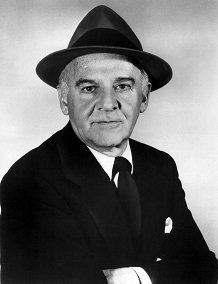
Winchell was a newspaper columnist and radio host [6] who Josephine knew to speak to. He was there that night, and she cited him as a witness. But Winchell was an old friend of Sherman Billingsley, the owner of the club, and said that Josephine was either mistaken or lying. Matters escalated, with Winchell accused of racism by Josephine’s supporters. Winchell in turn accused Josephine of being a Communist (though far from a Communist herself, she did have connections), and also (based on her old remarks about Mussolini) accused her of being pro-fascist. Smearing his opponents with the Communist brush was standard practice for discrediting black activists at the time, and was old hat for Winchell who was an ardent supporter of Joe McCarthy. The problem was that he had enough connections to make the accusation stick. The FBI became involved, and public opinion began to turn against Josephine. The black community began to regard her as a troublemaker (she was an outsider, after all) while the actual racists leaped on the mess – she received death threats from the Ku Klux Klan. Though her work visa wasn’t revoked, she decided to cut her tour of the US short and head to South America. But there rumours of her Communist affiliation meant that many countries refused her entry, while her discussion of her treatment was now interpreted by the American press as “anti-Americanism”. In the last stop of her tour, in Cuba, she was actually arrested and detained as a Communist spy and was pressured to sign a confession that she was a paid propagandist for Moscow. She managed to avoid signing it but returned to France in despair.
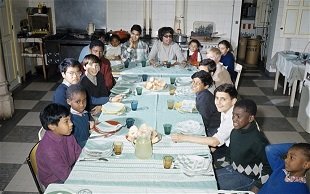
The stillbirth of Josephine’s child in Casablanca during the war had finally led her to accept that she wouldn’t be able to have any children of her own, and so after the war she had begun looking into adoption. With her newly fired up political consciousness, Josephine decided on an ambitious (if somewhat heavy handed) project. In order to prove that racial divides were artificial, Josephine decided to adopt a dozen children from all around the world. Her “Rainbow Tribe” would act as an example of multiculturalism. In practice, things proved a touch messier. Though Josephine’s intentions were good, she was far from perfect. Notably one of the children (Moise) was meant to be Jewish, but when Josephine could find no Jewish orphans to adopt she adopted a French one and had him brought up as Jewish. Raising such a large number of children (and keeping them in the public spotlight as an example) proved both expensive and stressful. Jo Bouillon had also signed up to the project, but he and Josephine fought bitterly, and eventually he divorced her and moved to Argentina. In another regrettable incident, when Josephine found out that one of the boys from the Tribe (Jarry, the Finnish orphan) was gay, she threw him out to go live with his adoptive father. In 1964 Josephine was declared bankrupt, and her mansion at Les Milandes was seized by her creditors. Josephine was forced to rely on her old friend Grace Kelly, now Princess Grace of Monaco, who gave her the use of one of her royal residences. The Tribe was broken up – some went to Monaco, and some went to live with a friend of Josephine’s in the UK.
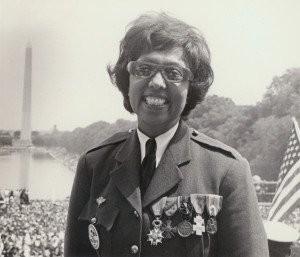
The 1960s was when the Civil Rights movement in America kicked into overdrive, and in 1963, when an alliance of civil rights groups planned The Great March on Washington, Josephine was invited to attend. The March, with its strong message of integration (as opposed to the black nationalism preached by Malcolm X) was a good match to Josephine’s own politics, and she accepted. Bobby Kennedy (a fan of Josephine) used his influence to get her visa through despite the unpleasantness of 1951. Josephine wasn’t one of the “official” speakers to the March, [7] instead she gave a speech during the introduction before the main speakers. Of those speeches, the most well remembered is that of Martin Luther King (”I have a dream”). But Josephine’s speech was also a powerful one. She stood before them in her Free French uniform, wearing her medals, and she spoke.
You know, friends, that I do not lie to you when I tell you I have walked into the palaces of kings and queens and into the houses of presidents. And much more. But I cold not walk into a hotel in America and get a cup of coffee, and that made me mad.
…I am not a young woman now, friends. My life is behind me. There is not too much fire burning inside me. And before it goes out, I want you to use what is left to light that fire in you. So that you can carry on, and so that you can do those things that I have done. Then, when my fires have burned out, and I go where we all go someday, I can be happy.
…[I have] an invitation to visit the President of the United States in his home, the White House. I am greatly honoured. But I must tell you that a coloured woman — or, as you say it here in America, a black woman — is not going there. It is a woman. It is Josephine Baker. This is a great honour for me. Someday I want you children out there to have that great honour too. And we know that that time is not someday. We know that that time is now.
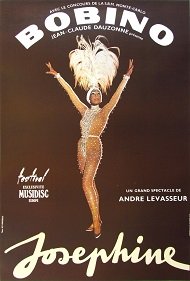
Josephine’s speech painted a narrativised version of her life, one where racial prejudice in France was glossed over while her actions in 1951 were recast as part of the rallying cries for the later civil rights movement. It was a performance, though on a different stage, and it was as well received as her performances always were. During the rest of the 1960s Josephine continued to visit America, though to visit rather than to perform. In 1968, when Martin Luther King was assassinated, Josephine was asked by his widow, Coretta Scott King, to take his place at the head of the Civil Rights movement. Josephine considered it, but declined. Her stated reason was that “her children were too young to lose their mother”. (Coretta eventually decided to take on the role herself.) That year Josephine made one of her now rare appearances in concert in Paris. She sold out Carnegie Hall in 1973, and played at the London Palladium in 1974. The crowning piece was a retrospective of her career at the Bobino Theatre in Paris, celebrating her fifty years in showbusiness before a star-studded audience. It was a glorious success. The TV news covered it and the critics wrote rapturous reviews of it. Four days later, Josephine was found in the morning lying in bed surrounded by those reviews. She had suffered a stroke and gone into a coma. A few days later on the 12th April 1975 she died, aged 68.
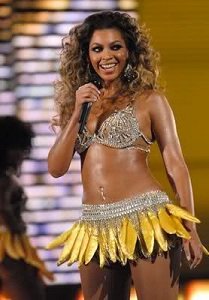
Josephine received a full French military funeral, as befitted a war hero, with a gigantic procession in Paris and public mourning. A street in Paris was named after her, and she became a part of French cultural history. In America she remained (and remains) relatively obscure, though she has had a definite influence. In 1986 two members of the Rainbow Tribe (Jarry and Jean Claude) opened a restaurant in New York named Chez Josephine after Josephine’s bar in Paris. In 1991 HBO made a TV movie on The Josephine Baker Story. The advertising compared her to modern stars like Madonna, and the film (which covered Josephine’s entire life) made a lot more people aware of this. Capitalising on this fame, Jean-Claude Baker wrote a biography called Josephine: The Hungry Heart which was released in 1993. Though the book has a distinctive hero-worshipping slant, Jean-Claude’s relationship to Josephine let him get interviews from people who new her throughout her life. It remains probably the most in-depth resource on her. As a new generation of black female artists rose to prominence around the turn of the century, Josephine was an inspirational figure for many of them. The most obvious of these is Beyonce, who gave a live performance in 2006 wearing a costume based on Josephine’s famous banana skirt and with dance routines inspired by Josephine’s dancing. With other artists like Janelle Monae citing her as an influence, it would seem that Josephine’s wish did come true. So long after her own fire burned out, the fire she lit keeps on going.
Images via wikimedia except where stated.
[1] Actually, marriage below the age of 15 was actually legal in Missouri – but only if authorized by a court order “for good cause and unusual conditions”.
[2] Naturally this meant it was a financial disaster, though both men considered it their finest joint work.
[3] She originally approached Ethel Waters, who turned her down – something the jazz and blues legend later ruefully admitted was probably a mistake.
[4] Josephine’s third film – she plays an African girl who a visiting novelist becomes infatuated with. He brings her back to Paris, his wife gets jealous, hijinks ensue. It’s not a bad film, and the scene where Josephine is unable to resist dancing on stage with a band is a definite highlight. However the ending isn’t great, and as always Josephine doesn’t get the guy. Trivia note: the film’s title was taken as the name of a modern French lingerie company.
[5] For example, the one for the Trenton Six – a group of young black men who had been arrested for murdering a white shopkeeper and convicted based on false evidence and confessions signed under duress.
[6] And later that decade, narrator for the TV show The Untouchables.
[7] The lack of any “official” female speakers at the March was a serious sore point with the women involved in the Civil Rights movement, who frequently felt that they were sidelined despite their contributions. The “introduction” did feature the likes of Rosa Parks and Daisy Bates, but they were taken offstage before the main speeches began.

The Beautiful and Sexy Woman